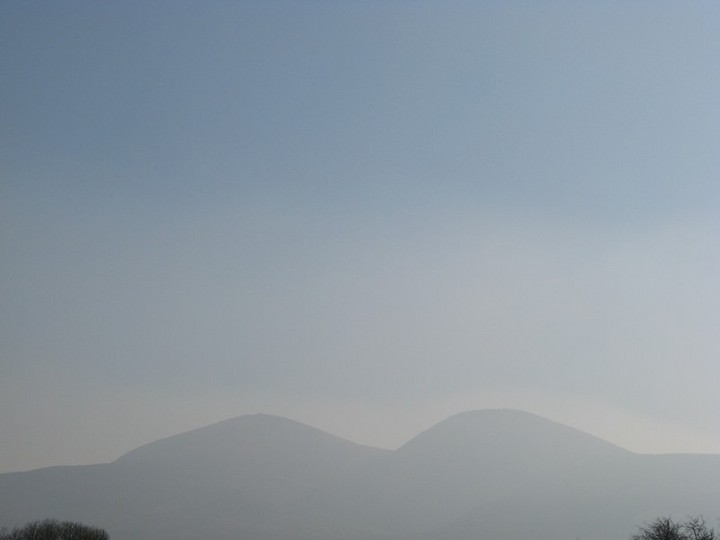
The paps from the well at The City of Shrone

The paps from the well at The City of Shrone

The Paps from near Rathmore

Sculpture of Danu herself

Great information board
Taken from info board at The City of Shrone
‘On our right, we were much struck with the singular appearance of the two hills, called The Paps. They are smoothly formed to the fairest proportion, imitating the outline of a woman’s bosom‘
Diary of Traveller on Butter Road in 1797 from visit to Killarney Lakes
The Paps are named after Anu, prinicipal Goddess of pre-Christian Ireland and mother Goddess of the Tuatha De Danann, a legendary group of divine invaders who ruled Ireland until their final defeat at the hands of the Milesians. The Goddess Anu brought prosperity to Munster. Anu or Danu who appear to be one in the same divinity, was originally a European Goddess, her name being commerorated most famously in the River Danube. Anu is also identified with the Mor Riogach, a war fury or Goddess whose name means great queen, together with Badbh and Macha, she was one of the triad of War Goddesses known as the Morrigna, manifesting themselves as ravens. Immediately to the North East of the higher Pap is an area called Gleannfreagham “The Glen of the Crows” and a small lake of the same name. Such names in proximity with the mountains called after Anu shows how mythology lives on in place names. Ravens still inhabit this Glen and in suitable weather conditions can be seen gliding on the thermals above the cairns on the summits of the Paps.
The Paps’ cairns appear to be part of a deliberately placed series which overlook the plains of the southwest. The cairn on the eastern peak is a substantial monument, measuring a height of 4 metres and a diameter of 18m-20metres. The entrances of both cairns are aligned westwards, towards the setting sun. It is thought that the cairns contain Neolithic burial chambers. They are the subject of ongoing study and excavations to confirm such theories.
Taken from the information board in Rathmore
Danu, sometimes referred to as Anu, is the ancient Celtic goddess of fertility, prosperity and comfort, and has representation in other forms across Europe, such as Dennitsa (Russian, Danae (classical Greek) and Dinah (Hebrew), as well as linking her with the role of Earth Mother. Comparision have also been made by a number of scholars between Danu and the Greek goddess Demeter. Many place names thoughout Europe are derived from the name of Dany, examples being the River Danube, the River Donn and Denmark. In Celtic legend, it was thought that the Tuath De Dannann, the ancient Celtic warrior-race, were descended from her and her consort, Bile.
Danu’s primary associations are with the processes of the agricultural cycle, as throughout Europe, Britain and Ireland, in particular Munster, she was highly revered by pre-Christain agricultural communitites as the guardian of cattle and health. Farming and land cultivation were of vital importance to those ancient Celtic people providing food and sustenance to see them through the long bleak winter.
During the ancient festival of Beltane (celebrated on 01 May), which heralded he end of the long dark winter, and gave the promise of brighter summer days ahead, fires (known as Bel-fires or Need-Fires) were lit on high ground, and livestock were herded between these fires, tradition has it, to ensure their health and fertility for the coming year. The ashes from the fires were then scattered in the fields, to ensure a bountiful harvest. These rituals would be carried out to “appease” the ancient deities, particularly Dany, the earth Mother.
In Duhallow, Danu is associated with the two hills in its South Western region, known in Irish as Dha Chioch Anann or the Paps of Danu. Agriculture has very strong associations with this region, the fertile Blackwater valley playing a vital and integral part in the lives of the inhabitants from pre-Christain times to the 21st century. Habitation of this region during the pre-Christain era is strongly evident in the many ancient ring-forts and settlements to be found in Duhallow region and many place names beginning with Lios (e.g. Lisnashearshane (near Cullen) – Lios na Seirsean – Fort of the Arches) or Rath (Rathroe (near Derrinagree) – Rath Ruagh – Red Fort). Dromtariffe (Drom Tairbh – Ridge of the Bull) is another example of an agriculturally associated place name in Duhallow, signifying the value placed on cattle in the area then, as now.
A number of Holy Wells are also evident in the Duhallow area. Pattern Days were held to honour the saints associated with each well. The City in Shrone, at the foot of the Paps, known in Irish as Cathair Crobh Dhearg is a prime example. This area was named for a local saint, St. Crobh Dearg, who has been linked by scholars in a triad with St. Laitiaran (Cullen) and St. Gobnait (Ballyvourney). Many scholars believe that sites such as this were originally ancient pagan sites of worship that were subsequently Christainised. In the pre-Christain/Celtic era, a beautiful woman-Goddess Creide (the Celtic version of St. Crobh Dearg, or a derivative of Danu, perhaps?) was associated with the same area and legend has it that she was declared by Fionn MacCumhail to be “.... the greatest flirt in Ireland”
Text and images.
Get your paps out for the landscape!


























































